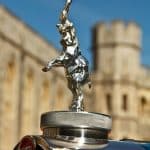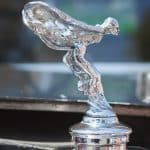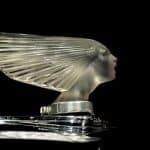On the Hood: Ornamental, Elegant, and Symbolic
by Jessica Kosinski
Have you ever owned, driven or seen a vehicle with a hood ornament? It is likely you have, since hood ornaments play a large part in automobile history. They are not standard on modern vehicles, but they are often seen on older automobiles. Also known as mascots, they are symbols of style and elegance. They are also highly collectible today. Let’s take a peek at how they have gone from practical vehicle features to decorative accessories and gained collectible status over the years.
The Origins of Mascots
Historically, mascots did not start out as vehicle hood ornaments. In fact, similar mascots have been used for centuries in many countries. They were simply symbolic figures, often affixed to forms of transport. One famous historical example is that of a sun-crested falcon. It was a good luck symbol used by the famous Egyptian pharaoh King Tut and was prominently attached to his chariot.
How Automobile Mascots Got Their Start
Today, automobile mascots are commonly known as hood ornaments. When you hear the term “hood ornament,” you may think of a figure affixed to the front of the vehicle for show. However, early car mascots served an important function. They were used to top radiator caps, which were exposed in early vehicle models. Drivers used such mascots to measure their coolant temperatures.
The Evolution of Hood Ornaments
Over time, car designs changed. Eventually, radiators were fully concealed under car hoods. The tradition of affixing hood ornaments to cars continued anyway because they were also valued for their symbolism and beauty at that time. Some were associated with particular automobile manufacturers and used for advertising purposes. Over the years, many hood ornaments have been ordered specially to designate vehicles owned by specific organizations or groups. Eventually, third party manufacturers began producing them in all sorts of designs by custom orders from vehicle owners wanting symbols significant to them personally. For example, depictions of favorite animals and people were often requested. In that sense, car mascots became true hood “ornaments” reflecting the personalities of vehicle drivers. They have continued to be valued by collectors for their origins, artistic designs and symbolic significances ever since.
The “Golden Age” of Hood Ornaments and Their Decline
The time period from 1920 to 1930 was known as the “Golden Age of Motoring.” During that time, both European and American automobile makers started producing many of the most artistic hood ornaments. That trend extended well into the 1950s. Therefore, that entire period was a “Golden Age” for hood ornaments. Unfortunately, safety concerns and related regulations caused the practice of affixing hood ornaments to modern vehicles to virtually end by the 1970s. They are now primarily known only as collectibles reminiscent of the early days of automobiles. Modern vehicles have flat emblems representing their manufacturers, instead.
Famous Hood Ornament Producers
Most of the famous vehicle manufacturers had designated artists or companies responsible for producing their hood ornaments. For example, 1920s Buick mascots were produced by a company called Ternstedt Co., which was based in Detroit, Michigan. Many famous sculptors also contributed to the vast array of hood ornaments admired and collected today. Among them were Sykes, Renevey, and Bazin. Another of the most famous sculptors who also designed hood ornaments was René Lalique. Mr. Lalique was one of the most admired glass sculptors in France. He designed 29 hood ornaments from 1925 to 1931. They adorned some of the most popular vehicles of the period, including Mercedes-Benz.
There are many hood ornaments that are so iconic they are highly coveted or easily recognized today. For example, the dancing elephant design of Bugatti is instantly recognizable to many hood ornament collectors. The Bentley “Flying B” and the three-pointed star of the Mercedes-Benz line are also iconic. In some cases, hood ornaments representing certain companies are also iconic because they belonged to specific vehicles or represented certain years. For example, the Oldsmobile hood ornament design changed multiple times throughout the years, allowing them to be easily dated by collectors.
In terms of value, the “Spirit of Ecstasy” made for Rolls-Royce and designed by Charles Sykes is among the most expensive hood ornaments. It is also called the “Flying Lady,” “Emily” or the “Silver Lady.” It has been reproduced many times over the years. In fact, designer Jean Kemanjian created a diamond-encrusted version that was valued at $200,000 as of 2015.
Collecting Hood Ornaments
If you want to collect hood ornaments, you should know there are several advantages to doing so. First, their values vary greatly, so you can collect ornaments within your budget. Second, they are small and easy to display. Third, they come in such a huge variety of designs – you can easily find ornaments to suit your preferences. For example, you can opt to collect only ornaments representing certain brands or vehicle models. Alternatively, you can also take advantage of the fact that so many private designers have created hood ornaments over the years in almost every style imaginable. You can even find hood ornaments depicting popular cultural figures like Mickey Mouse, if you so choose.
There are many places you can purchase hood ornaments. They can be found online, in antiques shops and in specialty stores. However, you have to be careful when buying them, if you care about authenticity and monetary value. Many have been reproduced over the years, and the reproductions often have much lower monetary values than their original counterparts. If you want to collect them, you must educate yourself about when and how they were originally made and how to recognize originals. Consult automobile historians and publications devoted to hood ornament collecting for advice before making major purchases.
Jessica Kosinski has been a freelance writer specializing in writing short articles for 15 years. She is also an avid collector of both antique books and Star Wars memorabilia. Although she is not in the antiques industry professionally, she has learned a lot about antiques over the years by periodically helping out at her mom’s antiques shop in Greenville, NH. She currently balances maintaining the antiques shop’s Facebook page, www.facebook.com/MallofNE, and working on various freelance writing assignments. She can be reached at dementorskiss77@yahoo.com.










Related posts: